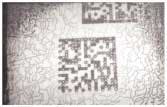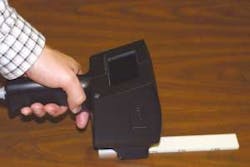Laser-based marking methods
When researchers at the University of Tennessee Space Institute (UTSI) were asked to apply their space expertise to medical problems on earth, they had a dilemma. Being engineers they knew they couldn't (or shouldn't) operate on people, so the challenge became how to translate engineering developments into medical solutions.
Fortunately researchers working at the Center for Laser Applications at UTSI had spent years investigating the interaction of lasers with materials and were ready for the challenge. A visit to a University of Tennessee hospital made the connection obvious—laser marking and tracking of expensive medical instruments used in surgery.
Hospitals lose millions of dollars each year in misplaced and damaged instruments. Just sorting and tracking instruments expends significant resources. Following sterilization, instruments are individually identified and packaged into kits for the operating room. It is a time-consuming process requiring well-trained employees. A permanent identification system would both simplify and speed up the process, while saving hospitals and patients a lot of money.
However, there were several significant hurdles: the mark selected had to accommodate a lot of information in a small space and codes would have to be easily changed to provide a unique identification number for each instrument. The mark would also have to survive sterilization.
Researchers decided to use the technology of 2-D matrix marking, specifically data matrix, which, unlike linear barcodes, configures the information in two dimensions and can be made very small—some marks storing up to 3,000 characters. In addition, the error correction embedded into the data matrix marks has been time tested and proven, recovering information even when 30 percent damage is sustained, making them very reliable. These marks are also readily resolved with common mark reading systems. A typical 2-D matrix mark is shown in Figure 1.
null
The small marks required necessitated the use of a laser marking system. Other marking techniques were too large, too messy or slow and cumbersome. Because millions of instruments would eventually be marked, a technique was needed that could easily and quickly apply a small unique mark. A laser fit the bill.
null
RVSI/Acuity CiMatrix (Canton, MA), a world leader in machine vision systems, has developed the Surgical Instrument Reader (see Figure 2) specifically designed to decode data matrix symbols directly laser marked onto the surface of surgical instruments. The specialized reader eliminates manually checking each instrument, allowing the automatic logging of instruments as they are prepared for use during surgery, or the identification of instruments scheduled for replacement.
The next hurdle was larger. Surgical instruments are subjected to brutal environments during sterilization making more benign forms of labeling unreliable. Commonly used cleaning processes such as alcohol wipe, ethylene oxide, hydrogen peroxide plasma, peracetic acid cleaning and steam sterilization are used. In the past when hospital trials were conducted on instruments bearing permanent laser marks, the sterilization processes produced corrosion in the region of the marks. This obscured the mark and prevented the reader from being able to decipher the information, rendering the mark useless. Clearly, a non-corroding mark was needed.
The UT researchers developed a laser marking technique, Laser Induced Surface Improvement (LISI), to meet this need. This involves applying a thin film of a selected precursor that is alloyed into the mark using the energy from a laser. Because many instruments contain minimal amounts of chromium to provide corrosion resistance, additional chromium can be selected for the precursor. When the chromium composition is raised, the problem of corrosion is virtually eliminated.
This technique has proven successful and is now being commercialized by Censis Technologies in Franklin, TN (http://www.censis.net/). Censis licensed the technology from the University of Tennessee Research Corporation last year, and is currently conducting beta tests in Nashville area hospitals. The company plans to begin selling its product commercially later this year.
Jim Harrison, president of Censis, says the company has a unique product to offer, which puts it ahead of its competition. The laser-applied mark allows each individual instrument to be catalogued and tracked. Southern Hills Medical Center in Nashville has been testing the system since last September and, according to Pat Ridling, director of surgical services, they are happy with the results.
Ridling gave some observations in a recent interview with the Knoxville Journal. "Never before have we been able to track our instruments," she said. "This way we know each time that the instrument has been used. It's really just a real good tracking system."
Censis is still marking instruments for the hospital and now has more than 65 percent of the instruments marked. Eventually all of the instruments will be finished and become part of the tracking system. "At this point, unless something really changes, we're thrilled with the system," Ridling says. "I think (marking instruments) is really only the tip of the iceberg of what can be done with this."
The UT researchers agree with Ridling. "These are permanent," says Diane Scarborough, marking research specialist. "The hospitals have already shown that the marks can withstand harsh environments. And hospitals aren't the only arena that need such marks." The world is moving toward accountability. Without good marking and tracking technology, there is no trace-ability and therefore no accountability.
The new exciting arena for the research lies with the next generation of readers, the instruments that translate the marked code into useable information. RVSI and NASA Marshall Space Flight Center along with PRI (Torrance, CA) have been developing magnetic, ultrasonic and x-ray readers that are capable of imaging marks covered with protective finishes. This requires marks with compositions that have special physical traits, which LISI marks can provide. Working with these organizations, UTSI researchers are testing marks that can be read through paint (RTP readers) or other obstructions such as corrosion, grease etc. The challenge now is to develop a combination of mark and reader that optimizes the attributes of both.
The magnetic scanner is commercially ready and easily reads through six layers of paint. The DOD and automotive industry are impressed with what they have seen. LISI could be used to surface treat magnetic materials permanently into the substrate, a feature that would be highly desirable in harsh operating environments. This opens the door to numerous automatic identification applications previously thought impossible. Reading through paint, cloth and other materials or coatings makes hidden marks a new security opportunity. This technology is being proposed as a security measure on identification badges and cards.
The UTSI researchers are very excited about the future of laser marking. Between the new readers being developed and the new techniques for marking, there is a burgeoning arena for research and development.
Dr. Mary Helen McCay is a professor of materials science and metallurgical engineering at the University of Tennessee Space Institute. She can be contacted at (865) 974-0522 or [email protected].


